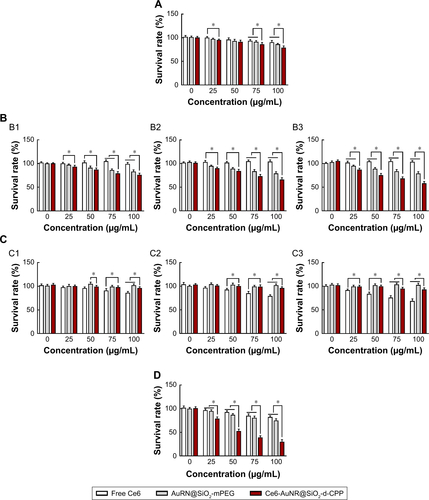Figures & data
Figure 1 A schematic procedure for preparation of functional chlorin gold nanorods.
Abbreviations: APTES, aminopropyl triethoxysilane; AuNR, Au nanorod; Ce6, chlorin e6; d-CPP, D-type cell penetrating peptide; Mal-PEG2000-NHS, maleimide PEG N-hydroxysuccinimide ester; PEG, polyethylene glycol; TEOS, tetraethyl orthosilicate; CTAB, cetyltrimethylammonium bromide.
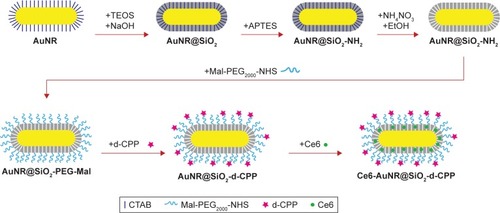
Figure 2 Characterization of functional chlorin gold nanorods.
Notes: (A) UV–Vis–NIR spectra of prepared gold nanorods. The vertical line indicates 808 nm and the shaded area represents the near infrared light bio-window. (B) TEM image of AuNR (B1), AuNR@SiO2 (B2), and Ce6-AuNR@SiO2-d-CPP (B3). The encapsulation efficiency of Ce6 in Ce6-AuNR@SiO2-d-CPP was 71.2%±1.1% and the modification rate of d-CPP in Ce6-AuNR@SiO2-d-CPP was 23.1%±1.4%. (C) Zeta potential distribution of prepared gold nanorods. (D) Cumulative Ce6 release rates of Ce6-AuNR@SiO2-d-CPP in the PBS at different pH values (D1), and in the PBS (pH 7.4) after 808 nm NIR exposure (D2). Data are presented as the mean±SD (n=3).
Abbreviations: AuNR, Au nanorod; Ce6, chlorin e6; Ce6-AuNR@SiO2-d-CPP, chlorin gold nanorods; d-CPP, D-type cell penetrating peptide; NIR, near infrared; TEM, transmission electron microscopy; UV–Vis–NIR, ultraviolet–visible–near infrared.
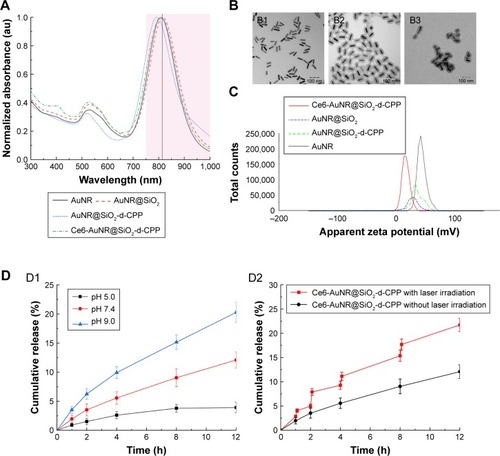
Table 1 Characterization of gold nanorods
Figure 3 Uptake study of AuNR@SiO2-d-CPP in the breast cancer cells.
Notes: (A) TEM images of AuNR@SiO2-d-CPP in the breast cancer cells after endocytosis. The right part was the enlarged picture of red dash rectangle in the left part. The arrows indicate AuNR aggregates; (B) temperature effect on the uptake by breast cancer cells of AuNR@SiO2-d-CPP; (C) the effects of endocytosis inhibitor on the uptake by breast cancer cells of AuNR. Data are presented as the mean±SD (n=3). *P<0.05, vs the controls.
Abbreviations: AuNR, Au nanorod; d-CPP, D-type cell penetrating peptide.
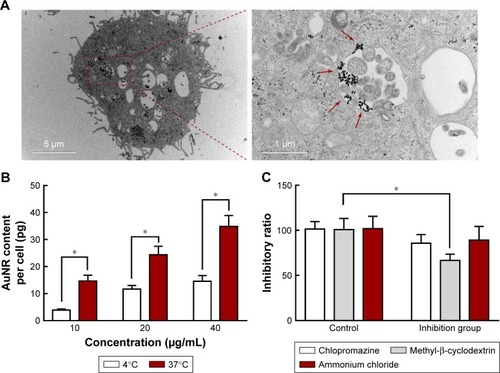
Figure 4 Survival status of breast cancer cells after treatment with Ce6-AuNR@SiO2-d-CPP under PTT/PDT.
Notes: The survival was observed under fluorescence microscope. The green fluorescence represents live cells stained by calcein AM, while the red fluorescence indicates the dead cells (after laser irradiation) stained by ethidium homodimer. Treatment details: blank control, PDT (free Ce6 with exposure to 50 mW 650 nm laser for 10 minutes), PTT (Ce6-AuNR@SiO2-d-CPP with exposure to 2 W 808 nm laser for 10 minutes), and PTT/PDT (Ce6-AuNR@SiO2-d-CPP with exposure to 2 W 808 nm laser for 10 minutes plus 50 mW 650 nm laser for 10 minutes). Scale bar =200 µm.
Abbreviations: AuNR, Au nanorod; Ce6, chlorin e6; Ce6-AuNR@SiO2-d-CPP, chlorin gold nanorods; d-CPP, D-type cell penetrating peptide; PTT/PDT, photothermal/photodynamic therapy.
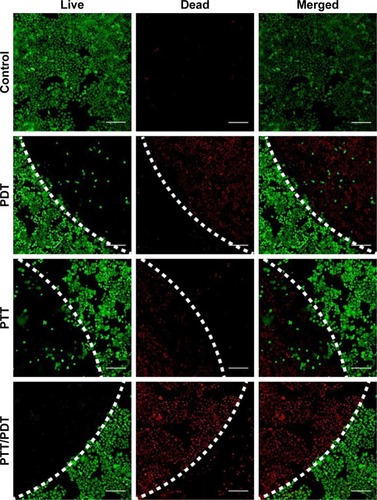
Figure 5 Apoptosis of breast cancer cells after treatment with Ce6-AuNR@SiO2-d-CPP under PTT/PDT.
Notes: Bright field presents the cell morphology and green channel indicates the early apoptotic cells. The cancer cells were exposed to Ce6-AuNR@SiO2-d-CPP except control group. Laser irradiation details: blank control (none), PTT (808 nm, 2 W, 5 minutes), PDT (650 nm, 50 mW, 5 minutes), and PTT/PDT (808 nm, 2 W, 5 minutes plus 650 nm, 50 mW, 5 minutes). Scale bar =100 µm.
Abbreviations: AuNR, Au nanorod; Ce6, chlorin e6; Ce6-AuNR@SiO2-d-CPP, chlorin gold nanorods; d-CPP, D-type cell penetrating peptide; PTT/PDT, photothermal/photodynamic therapy.
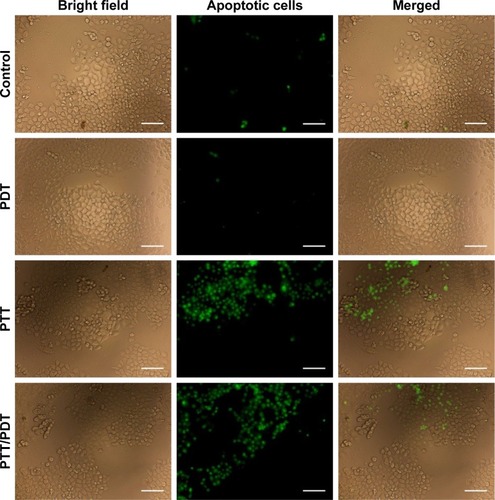
Figure 6 Apoptotic mechanism of breast cancer cells after treatment with Ce6-AuNR@SiO2-d-CPP under PTT/PDT.
Notes: (A) The produced singlet oxygen levels in liquid state under different laser irradiation modes measured by a fluorescence spectrophotometer; (B) the ROS levels in breast cancer cells after treatment with Ce6-AuNR@SiO2-d-CPP under PTT/PDT laser irradiations recorded by a multimode reader; (C) activity ratios of upstream apoptotic enzymes caspase 8, 9, downstream caspase 3/7, and apoptotic protein cytochrome C measured by the Operetta high-content screening system; (D) the changes of mitochondrial membrane potential recorded by a multimode reader. Data are presented as the mean±SD (n=3). *P<0.05, vs the controls.
Abbreviations: AuNR, Au nanorod; Ce6, chlorin e6; Ce6-AuNR@SiO2-d-CPP, chlorin gold nanorods; d-CPP, D-type cell penetrating peptide; PTT/PDT, photothermal/photodynamic therapy; ROS, reactive oxygen species.
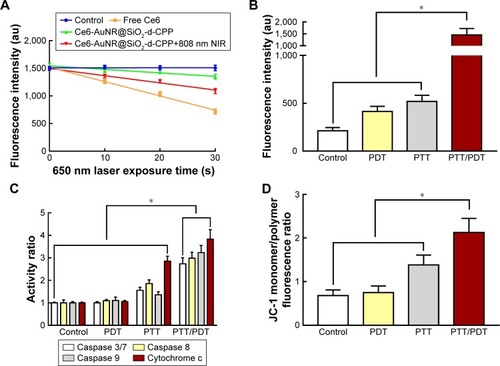
Figure 7 Anticancer efficacy in breast cancer xenografts in nude mice after treatment with Ce6-AuNR@SiO2-d-CPP under PTT/PDT.
Notes: This figure depicts the relative tumor ratio (A) and body weight (B) of tumor-bearing nude mice after treatment with functional chlorin gold nanorods under photothermal/photodynamic treatment mode. Ce6-AuNR@SiO2-d-CPP was intravenously injected into breast cancer tumor-bearing mice via tail vein at day 14, 16, 18, and 20 post inoculation. After treatment under PTT/PDT, the anticancer efficacy was estimated by the tumor volume ratio. The experiment groups consisted of physiological saline group (without irradiation), free Ce6 group (PDT by 650 nm 50 mW laser irradiation for 5 minutes), AuNR@SiO2-d-CPP group (PTT by 808 nm 2 W laser irradiation for 5 minutes), and Ce6-AuNR@SiO2-d-CPP group (PTT/PDT by 808 nm 2 W irradiation for 5 minutes and 650 nm 50 mW irradiation for 5 minutes). Data are presented as the mean±SD (n=6). Arrows indicate the drug-dosing time points. P<0.05; a, vs physiological saline; b, vs free Ce6; c, vs AuNR@SiO2-d-CPP.
Abbreviations: AuNR, Au nanorod; Ce6, chlorin e6; Ce6-AuNR@SiO2-d-CPP, chlorin gold nanorods; d-CPP, D-type cell penetrating peptide; PTT/PDT, photothermal/photodynamic therapy.
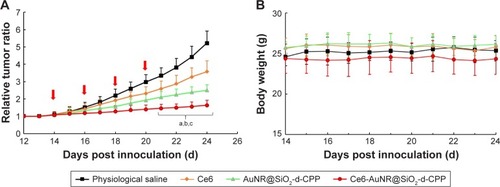
Figure S1 Photothermal effects of functional chlorin gold nanorods under the different treatment conditions.
Note: (A) Photothermal effects of functional chlorin gold nanorods under varying laser powers at 808 nm (AuNR solution fixed at 1 OD); (B) Photothermal effects of functional chlorin gold nanorods under varying AuNR concentrations (laser power fixed at 0.5 W); (C) Photothermal effects of functional chlorin gold nanorods under different kinds of AuNR formulations (808nm laser power fixed at 1.5 W). Data are presented as mean ± standard deviation (n=3).
Abbreviations: AuNR, Au nanorod; Ce6, chlorin e6; Ce6-AuNR@SiO2-d-CPP, chlorin gold nanorods; d-CPP, D-type cell penetrating peptide.
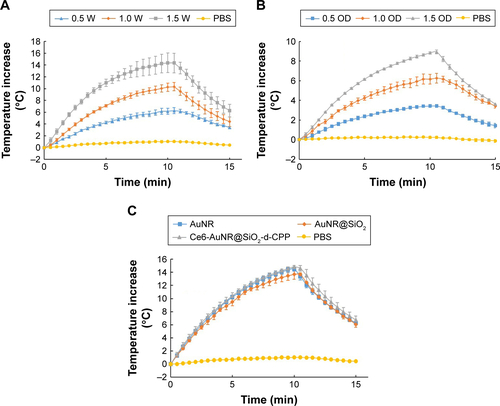
Figure S2 Vis-NIR spectrum of Ce6 solution (PBS 7.4).
Note: Ce6 has strong absorption peaks at 404, 503, and 667 nm, suggesting that the irradiation at 650 nm for PDT would not influence the irradiation at 808 nm for PTT (Figure S2), thus avoiding mutual interference of PTT and PDT during the experimental treatment.
Abbreviations: Ce6, chlorin e6; PTT/PDT, photothermal/photodynamic therapy; Vis-NIR, visible–near infrared.

Figure S3 Uptake of AuNR@SiO2-mPEG2000 and AuNR@SiO2-d-CPP by breast cancer cells.
Notes: The concentrations based on AuNR@SiO2-mPEG2000 were 10, 20, and 40 µg/mL, while the incubation times were (A) 3 hours, (B) 6 hours, and (C) 12 hours. Data are presented as the mean ± SD (n=3).
Abbreviations: AuNR, Au nanorod; Ce6, chlorin e6; Ce6-AuNR@SiO2-d-CPP, chlorin gold nanorods; d-CPP, D-type cell penetrating peptide; PEG, polyethylene glycol.
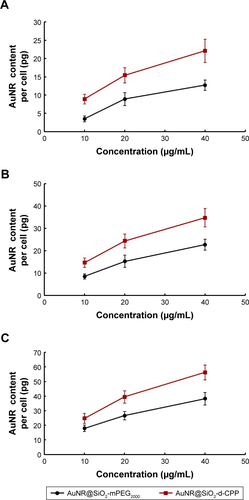
Figure S4 Cytotoxicity to breast cancer cells at varying concentrations of Ce6, AuNR@SiO2-mPEG, and Ce6-AuNR@SiO2-d-CPP in different mode.
Note: (A) Cytotoxicity in the dark; (B) photothermal effects after 3 minutes (B1), 5 minutes (B2), and 10 minutes (B3) 808 nm NIR irradiation; (C) photodynamical effects after 5 minutes (C1), 10 minutes (C2), and 15 minutes (C3) 650 nm NIR irradiation; (D) photothermal/photodynamic effects by combining 10 minutes 808 nm and 10 minutes 650 nm irradiation. Data are presented as the mean ± SD (n=3). *P<0.05, vs controls.
Abbreviations: AuNR, Au nanorod; Ce6, chlorin e6; Ce6-AuNR@SiO2-d-CPP, chlorin gold nanorods; d-CPP, D-type cell penetrating peptide; NIR, near infrared; PEG, polyethylene glycol.
